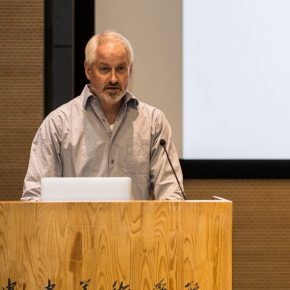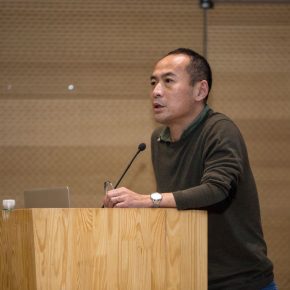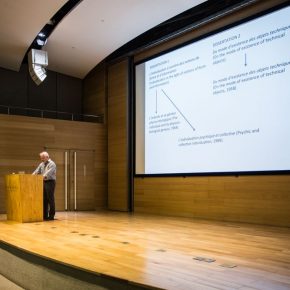
On the afternoon of December 19, 2017, CAFA CAT invited Prof. Thomas LaMarre from McGill University in Canada to give a lecture entitled “Understanding Gilbert?Simondon: Humans and Machines” at the Auditorium of CAFA Art Museum. Prof. Zhang Ga from the School of Experimental Art, hosted the lecture, and introduced Thomas LaMarre who teaches in East Asian Media and Communication Studies at McGill University, Canada. Thomas LaMarre, who was among the first to introduce Simondon to North America, gave a brilliant and systematic exposition of the core issues of Gilbert?Simondon’s thought.
Prof. Qiu Zhijie introduced the essential figure of this lecture – Gilbert Simondon, was one of the most important philosophers in the 20th century. His discourses on individuation and technology & culture, has greatly influenced many contemporary thinkers, including Gilles Deleuze, Bruno Latour, Bernard Stiegler, etc. Gilbert?Simondon’s philosophy of technology did not only profoundly rewrite the basic paradigm of ontology, but also remodelled the relationship between humans and machines, and even the relationship between humans and things, and also pointed out a clear method to resolve the traditional dilemma of culture and technology which has potentially laid a new ethical foundation for the equal demands of people, things and machines. His thoughts are of irreplaceable cognitive significance to the contemporary experiences dominated by digital technologies.
First of all, Prof. Thomas mentioned Gilbert Simondon’s sentence: “The robot does not exist.” He opposed modern discussions in the technical field – the endogenous or natural tendencies of mechanical engineering directed to a more fully developed automation and he did not think that machines and technologies were frightening because of the so-called endogenous robotic tendencies of dehumanization. The existence of machines was not essentially opposed to human activity. He wrote that “Culture has become an umbrella for humans who are in the face of technology”, because we assumed that there was no humanity for technical objects, but culture did not consider that there was a level of human reality in technical reality. If culture really played a role, assuming that the cognition of the existence of technical objects must have philosophical considerations, in order to solve the philosophical problem, it must re-establish the value of the existence of human beings, which was like the abolition of slavery.
“Technological Object” and “Personalized Process”??At the lecture, Prof. Thomas focused on Gilbert?Simondon’s exploration of the theory of technology, especially the concept of “technological object” in the context of Simondon’s philosophical thought. Simondon added a new dimension – “existential model” to the “technological object”, and he believed that the machine could also be regarded as a technical object, a technological existence and a technological existential model. For the existence of the individual and existence modes of different types of objects, Simondon’s philosophy usually has three different parallel relations: firstly, the physical objects, physical existences and physical individuals, for example, the crystallized crystal as the physical existence mode; secondly, the natural objects or living existence and living creatures, such as plants. Thirdly, the so-called technical objects, technological existence and technical individuals, such as the car engine.
Another characteristic of Simondon’s philosophy and a sign of his philosophy was that it usually treated a series of existential models, including machines, organisms, humans and societies, as individuals, from an implicitly non-normative perspective, that the process of individualization was regarded as the individual. Simondon’s understanding of man-machine relations was based on Norbert Wiener’s cybernetics and the perspective of Simondon’s tutor Canguilhem. He believed that people exist as a life and the machine exists as technology and are not in a binary opposition, the philosophic concept of individualization actually falls across all these complex orders to exist. In technical issues, technology, physics and biology were indivisible and entwined.
“Organs” or “Technological Existence”????Prof. Thomas took “crystal crystallization” as an example to start a personalized concept interpretation on the physical level. Seen from the mechanical individuality of technical level, Simondon thought that the machine was not purely a crystal-like physical existence, but carries the associated environment. Although the machines carried the associated environment, it also depended on the cycle in the external environment, so the machine would find and build the external environment, which required people’s help. Seen from the mechanical individuality on a biological level, the tools and machines could be regarded as organs. They were a form of existence that folded with the external environment and were included into the internal environment, which was like a being. For Simondon, the so-called contemporary character was the existence of technology or the existence of machines that were increasingly tended to for life existence.
Simondon saw a paradox proposed by the so-called technological existence of the human. When it was considered as an organ, the machine might resemble a tool or technical element and a man regarded him as a bearer or owner of the tool. When it was understood as the existence of technology, it was like a being, and human beings would feel the threat of autonomy, such technical individuals would force people to think. Once humans were the carriers and owners of tools, but one day the machines became the owners and carriers of tools, and human beings lost their social niche, which could also be regarded as the origin of modern society protesting about the relationship between humans and machines. This relationship has enslaved both the machines and humans. Simondon did not think that people have been granted the role of owners or users, nor the heaven-born owners of the machines, and the role of humans was to find the new position between the holders of the tools again. Human beings placed themselves in the machines, which actually placed themselves in the cross-individuation status, namely being aware of the most basic equality between humans and machines was the way to realize humans’ technological and social potential, in Simondon’s discourse.
Simondon’s insistence on man-machine technological equality is reminiscent of the concept of the aesthetic equality proposed by Jacques Rancière, but in fact, the technical equality and political equality are not exactly the same. Undoubtedly, true political equality cannot be imagined without a real technical equality between humans and machines. Prof. Thomas presented a dialectical lecture for the audience, which might inspire people to further share and discuss the relationships between humans and machines.
Text by Wu Huixia, translated by Chen Peihua and edited by Sue/CAFA ART INFO
Photo by Hu Sichen/CAFA ART INFO


































